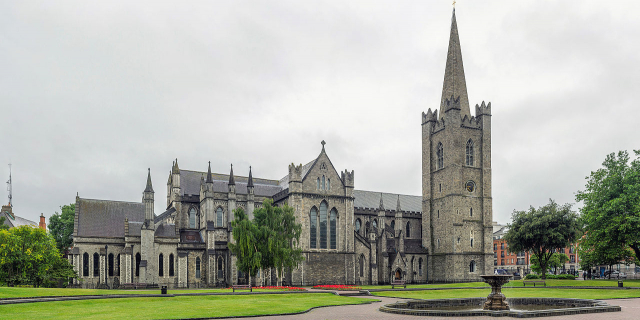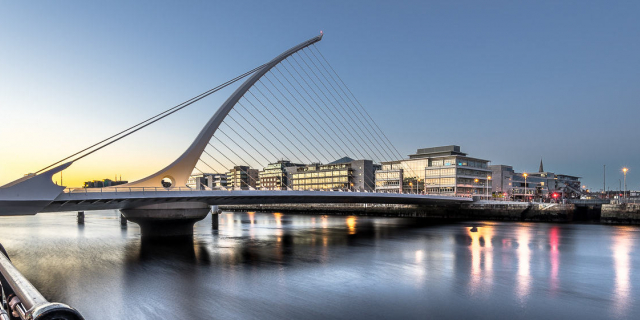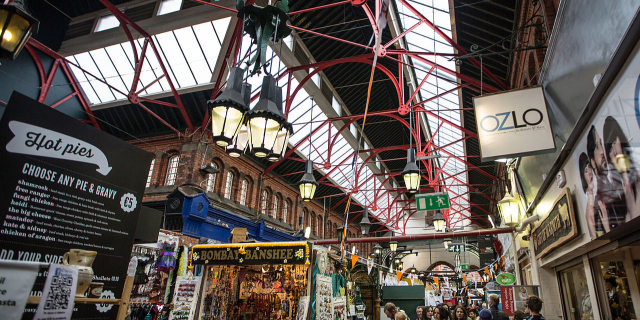St Stephen's Green
St Stephen's Green (Irish: Faiche Stiabhna) is a garden square and public park located in the city centre of Dublin, Ireland. The current landscape of the park was designed by William Sheppard. It was officially re-opened to the public on Tuesday, 27 July 1880 by Lord Ardilaun. The square is adjacent to one of Dublin's main shopping streets, Grafton Street, and to a shopping centre named after it, while on its surrounding streets are the offices of a number of public bodies as well as a stop on one of Dublin's Luas tram lines. It is often informally called Stephen's Green. At 22 acres (8.9 ha), it is the largest of the parks in Dublin's main Georgian garden squares. Others include nearby Merrion Square and Fitzwilliam Square.
The park is rectangular, surrounded by streets that once formed major traffic arteries through Dublin city centre, although traffic management changes implemented in 2004 during the course of the Lua...Read more
St Stephen's Green (Irish: Faiche Stiabhna) is a garden square and public park located in the city centre of Dublin, Ireland. The current landscape of the park was designed by William Sheppard. It was officially re-opened to the public on Tuesday, 27 July 1880 by Lord Ardilaun. The square is adjacent to one of Dublin's main shopping streets, Grafton Street, and to a shopping centre named after it, while on its surrounding streets are the offices of a number of public bodies as well as a stop on one of Dublin's Luas tram lines. It is often informally called Stephen's Green. At 22 acres (8.9 ha), it is the largest of the parks in Dublin's main Georgian garden squares. Others include nearby Merrion Square and Fitzwilliam Square.
The park is rectangular, surrounded by streets that once formed major traffic arteries through Dublin city centre, although traffic management changes implemented in 2004 during the course of the Luas works have greatly reduced the volume of traffic. These four bordering streets are called, respectively, St Stephen's Green North, St Stephen's Green South, St Stephen's Green East and St Stephen's Green West.
 St Stephen's Green, Herman Moll's 1714 map of Dublin
St Stephen's Green, Herman Moll's 1714 map of Dublin Photochrom print showing the green at the end of the 19th century
Photochrom print showing the green at the end of the 19th century The Green in 1832
The Green in 1832The association with St Stephen has its origins in a medieval leper hospital, now Mercer's Hospital, dedicated to Saint Stephen on nearby Stephen Street.[1] Until 1663, St Stephen's Green was a marshy common on the edge of Dublin of approximately 60 acres, used for grazing. In that year Dublin Corporation, seeing an opportunity to raise much-needed revenue, decided to enclose the centre of the common and to sell land around the perimeter for building. The area was surveyed by Robert Newcomen, with the land divided into 96 plots with a green of 27 acres in the centre. The park was enclosed with a wall in 1664. Early tenants built simple two-storey houses, with much of it undeveloped on the 1728 map. By the time of John Roque's map in 1756, the pace of building had accelerated rapidly.[2] The houses built around the Green were rapidly replaced by new buildings in the Georgian style and by the end of the eighteenth century the Green was a place of resort for the better-off of the city. Most of the present-day landscape of the square comprises townhouses from the 18th and 19th centuries.[3]
 Fusiliers' Arch, erected in 1907
Fusiliers' Arch, erected in 1907Saint Stephen's Green (Dublin) Improvement Act 1814Act of Parliament

In 1814 control of St Stephen's Green passed to commissioners for the local householders, who redesigned its layout and replaced the walls with railings.[4]
After the death of Prince Albert, Queen Victoria suggested that St Stephen's Green be renamed Albert Green and have a statue of Albert at its centre, a suggestion rejected with indignation by the Dublin Corporation and the people of the city, to the Queen's chagrin.[5]
Saint Stephen's Green (Dublin) Act 1877Act of Parliament

Access to the Green was restricted to local residents, until 1877, when Parliament passed an Act to reopen St Stephen's Green to the public, at the initiative of Sir A.E. Guinness, a member of the Guinness brewing family who lived at St Anne's Park, Raheny and at Ashford Castle. He later paid for the laying out of the Green in approximately its current form, which took place in 1880, and gave it to the Corporation, as representatives of the people. By way of thanks, the city commissioned a statue of him, which faces the College of Surgeons. His brother Edward lived at Iveagh House, which his descendants gave in 1939 to the Department of External Affairs (now the Department of Foreign Affairs).
During the Easter Rising of 1916, a group of rebels made up mainly of members of the Irish Citizen Army, under the command of Commandant Michael Mallin, his second-in-command Kit Poole, and Constance Markievicz, established a position in St Stephen's Green.[6] They numbered between 200 and 250.[7] They confiscated motor vehicles to establish roadblocks on the streets that surround the park, and dug defensive positions in the park itself. This approach differed from that of taking up positions in buildings, adopted elsewhere in the city. It proved to have been unwise when elements of the British Army took up positions in the Shelbourne Hotel, at the northeastern corner of St Stephen's Green, overlooking the park, from which they could shoot down into the entrenchments.[6] Finding themselves in a weak position, the Volunteers withdrew to the Royal College of Surgeons on the west side of the Green.[7] During the Rising, gunfire was temporarily halted to allow the park's groundsman to feed the local ducks.[8]
A statue of Archibald Montgomerie, 13th Earl of Eglinton by Patrick MacDowell was erected on the North side of the green in 1866. It was destroyed in an explosion by the IRA which injured gardai and civilians in 1958 and the remains were dismantled.[9][10]
The park is now operated by the Office of Public Works (OPW) on behalf of the Irish state.[11]




































Add new comment